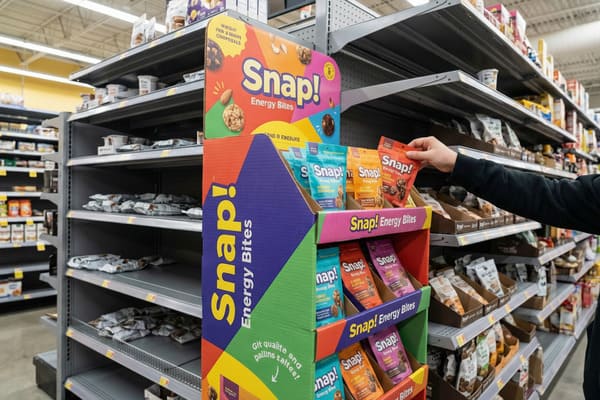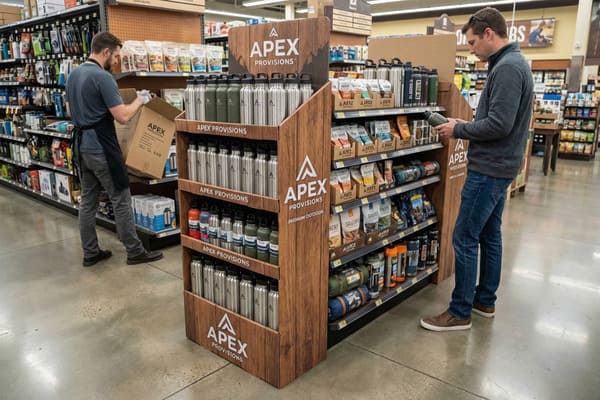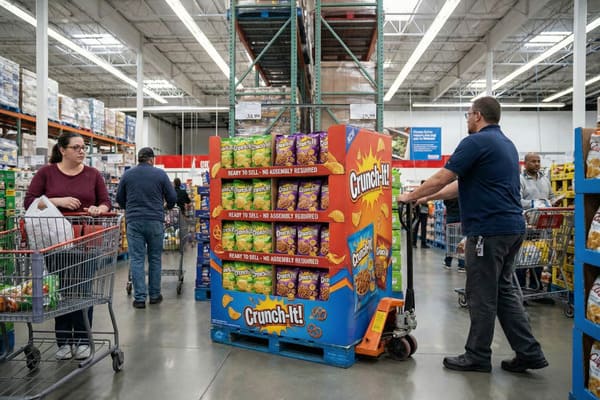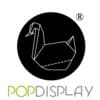A wobbly display kills sales faster than bad pricing. If you are launching a product in the US market, you don't just need a box; you need a silent salesman that survives the brutality of a Walmart distribution center and grabs a shopper's attention in under three seconds.
To make a cardboard display stand, the process follows a strict engineering sequence: 1. Structural Design (determining load capacity and style), 2. Prototyping (white sample testing), 3. Artwork Application (dieline fitting), 4. Mass Production (printing, die-cutting, gluing), and 5. Packing (flat-pack or co-packed). Each step requires specific material calibration to ensure stability.

Most brands think the design is just about pretty colors, but the real magic happens in the structural engineering. If you get the grain direction wrong, your stand collapses. If you mess up the shipping dimensions, you pay to ship air. Let's break down exactly what these displays are and how to engineer them for profit.
What is a corrugated display?
Shoppers are walking through stores in a trance, and standard shelving is just visual wallpaper to them. To break that trance, you need a structure that physically disrupts their line of sight and presents your product in isolation, away from the clutter of the aisle.
A corrugated display is a temporary, free-standing retail fixture made from fluted cardboard layers, designed to showcase products outside of standard shelf placements. These units are engineered to boost impulse purchases by increasing brand visibility in high-traffic areas like aisle ends or checkout counters.

The Structural Anatomy of Visual Disruption1
When we talk about corrugated displays, we aren't just talking about folded paper. We are talking about "Visual Disruption." I tell my clients all the time: if your product sits on the metal gondola shelf next to ten competitors, you are fighting a losing battle. A corrugated display isolates your product. But making one isn't as simple as folding a box. It starts with the material. In the US market, we typically use Corrugated Fiberboard, which consists of a fluted sheet glued between two flat linerboards.
The biggest mistake I see brands make is ignoring the "Decision Fatigue" of the average American shopper. They over-complicate the structure. The goal of a corrugated display is to present the product instantly. We use specific structural designs, like curvy die-cut shapes—which cardboard does far better and cheaper than metal—to grab attention. But here is the messy reality: cardboard hates moisture. A standard corrugated display sitting on a wet floor (after the night crew mops) will turn into mush. We call this the "Soggy Bottom" effect. It's a disaster. I've seen beautiful $50 displays collapse because the bottom two inches absorbed water.
To fix this, we don't just "make a box." We apply a biodegradable water-resistant coating or a "mop guard" to the base. We also have to calculate the "Grain Direction2" of the paper. If a designer places the grain horizontally on a load-bearing wall, that display will buckle under 20 lbs of weight. My engineers align the grain vertically to maximize the Box Compression Test (BCT) score. This allows us to use lightweight material that acts like a pillar, holding 50 lbs or more without sagging. It's about using physics to save money on material while boosting sales performance.
| Feature | Standard Shelf | Corrugated Display |
|---|---|---|
| Visibility | Low (Lost in clutter) | High (Isolated & 360° view) |
| Shopper Interaction3 | Passive | Aggressive (Interrupts path) |
| Material Cost | High (Metal/Fixed) | Low (Temporary/Recyclable) |
| Shape Flexibility4 | Rigid rectangles only | Unlimited die-cut shapes |
| Moisture Risk | None | High (Requires coating) |
I treat the bottom two inches of every floor display like the foundation of a house; if we don't waterproof that base with a proper coating or varnish, the entire investment can be ruined by a single mop bucket.
What is a display stand?
Understanding the terminology is half the battle when sourcing from overseas. While "display" is the broad term, a "stand" usually implies a specific structural footprint intended to hold weight, whether it sits on a counter or the floor.
A display stand is a rigid retail fixture, available in various formats like Floor Stands, Counter Units (PDQs), or Pallet Displays, specifically engineered to hold product inventory. Unlike simple signage, a display stand combines branding surfaces with load-bearing shelving to dispense products directly to the consumer.

Structural Hierarchy: From Counter to Pallet
Making a display stand requires distinct engineering based on where it lives in the store. You have three main beasts: the Floor Display, the Counter Display (PDQ)5, and the Pallet Display. Each has a different "physics profile."
Let's start with Floor Displays. These are the workhorses. But they have a fatal flaw: "The Shadow Zone." Retail lighting comes from the ceiling. If you build a stand with deep shelves and solid walls, the middle shelf is pitch black. Dark products don't sell. I learned this the hard way years ago when a client complained their bottom-shelf inventory wasn't moving. Now, we cut side windows or use white inner liners to reflect light. It's a simple tweak that increases visibility by 40%.
Then you have Club Store Pallet Displays6 (for Costco or Sam's Club). This is a different league. These aren't just "stands"; they are industrial structures. Costco has a "No-Overhang" rule that is incredibly strict. If your display sticks out 0.5 inches past the 48×40 pallet, they reject the whole truck. Plus, they demand massive load-bearing capacity—sometimes over 2,500 lbs dynamic load. We can't use standard B-flute here. We have to use EB-flute or double-wall corrugated board and often integrate "H-Dividers" or internal skeletons to prevent the walls from bowing out (the "bulge" effect) when filled with heavy goods like beverages.
Finally, Counter Displays. The issue here is the "Tipping Point." If a customer buys the front items, the center of gravity shifts back, and the display flips over. We have to design extended easel backs or weighted false bottoms to prevent this embarrassment.
| Display Type | Key Requirement | Common Failure Point |
|---|---|---|
| Floor Stand | Vertical Strength7 | Leaning/Buckling under load |
| Pallet Display | 48×40 Compliance | Overhang rejection at DC |
| Counter (PDQ) | Anti-Tip Balance8 | Tipping backward when empty |
| Dump Bin | Burst Strength | Walls bowing outward ("Pregnant" bin) |
I always measure the "Chin-Up" angle on lower shelves; by angling the bottom shelves up by 15 degrees, we force the product to look the customer in the eye rather than their knees, which drastically improves the pick-up rate.
What is a POSM display stand?
POSM stands for "Point of Sales Materials." In the manufacturing world, when a buyer asks for POSM, they are usually talking about the ROI calculation of the unit. They want to know how this cardboard box pays for itself.
A POSM display stand is a specialized category of marketing material placed at the exact point where a transaction occurs, designed to trigger impulse purchases. These units utilize high-impact graphics and strategic positioning to convert shopper attention into immediate sales, often yielding a high return on investment.

The ROI Equation and The "3-Second Lift9"
When I manufacture a POSM stand, I am not selling cardboard; I am selling a sales lift. US buyers often get scared of the unit price. They see a $20 display and think it's expensive. But that's the wrong math. I teach my clients the "3-Second Lift" concept. A standalone POSM display typically increases sell-through by 400% compared to the home shelf because it breaks the visual pattern.
The engineering focus here is on "Speed to Market" and "Visual Pop." For POSM, the print quality is everything. But here is the trap: Color Management10. Marketing managers approve designs on bright, backlit MacBooks (RGB). But we print with ink on paper (CMYK). This leads to the "Muddy Color" disappointment. A vibrant red on screen looks like a dull brick on cardboard. To make a POSM stand that actually pops, I use a GMG Color Proofing system. I don't trust the screen. I print a physical proof on the actual paper stock.
Another massive factor in POSM is the "Kill Date." These displays are temporary. If a Halloween display is still up in November, it hurts the brand. We actually print a code on the back that says "Remove By: [Date]" to help store execution. And for the structure? We focus on the "Strike Zone." The average American female shopper is 5'4". We design the "Hero Product" shelf exactly at 50-54 inches from the floor. That is the "Eye-Level Buy Level." If you put your high-margin item on the bottom shelf, you are throwing money away.
| Metric | Home Shelf (Standard) | POSM Display Stand |
|---|---|---|
| Sell-Through Rate11 | 1x (Baseline) | 4x – 5x |
| Brand Recall12 | Low | High |
| Visual Competition | High (Neighbors) | Zero (Standalone) |
| Setup Time | N/A | < 5 Minutes (Target) |
I advise clients to ignore the upfront cost of the display and look at the margin; if selling 50 extra units covers the cost of the structure on Day 2, the remaining 28 days of the campaign are pure, unadulterated profit.
What is the HS code for display stands?
If you import displays from China to the US, the HS Code (Harmonized System Code) determines your duty rate. Get this wrong, and you could face a surprise 25% tariff bill or get your container flagged for an intense exam at Long Beach.
The primary HS code for corrugated paperboard display stands is 4819.10, which covers cartons, boxes, and cases of corrugated paper or paperboard. However, depending on the specific content and function, some displays may be classified under 4823.90 or strictly as printed matter (4911.10), affecting the duty rate.

Navigating US Customs and Tariffs
Since the Trade War began, importing cardboard displays has become a minefield. The standard code is often 4819.10, but here is where it gets tricky. If the display is imported empty, it's packaging. If it's imported pre-filled with product (Co-packing), the classification changes entirely—usually, the display becomes secondary packing for the product itself, and you pay duty on the product's code, not the cardboard.
I help my clients "engineer the invoice." For example, distinguishing between "Printed Matter" (advertising material) and "Packaging Containers" can sometimes change the tariff exposure. But you have to be honest. US Customs has zero humor. I've seen containers stuck for three weeks because a supplier tried to be cute with the codes.
Another nightmare is the ISF 10+2 filing13. This needs to be filed 24 hours before the ship leaves China. Many factories forget this. If you miss that window, it's a $5,000 fine for the importer (you). That wipes out your profit instantly. My team has a dedicated logistics coordinator who sends this data 72 hours in advance. We also have to watch out for the "Volumetric Weight14" trap. Shipping "air" kills margins. I optimize carton sizes to fit the 40HQ container perfectly. Sometimes, changing a header card from a single piece to a bi-fold can save 20% of the container space. That's thousands of dollars in freight saved just by tweaking the fold lines.
| HS Code | Description | Typical Use Case |
|---|---|---|
| 4819.10 | Corrugated boxes/cases15 | Standard Displays |
| 4823.90 | Other paper/paperboard | Specialized Structures |
| 4911.10 | Trade advertising material16 | Signage/Headers only |
| 9403.89 | Furniture of other materials | Permanent/Semi-perm fixtures |
I don't just ship boxes; I provide the compliant documentation and specific HS code advice to ensure your container clears US Customs without triggering the punitive Section 301 tariffs unnecessarily.
How to assemble a display stand?
The best display in the world is worthless if the store employee throws it in the trash because they can't figure out how to build it. Assembly is the single biggest point of failure in the retail execution chain.
To assemble a display stand efficiently: 1. Unfold the main body (tower), 2. Lock the internal support tabs or auto-bottom, 3. Insert the shelves ensuring tabs click securely, 4. Attach the header card to the top, and 5. Place the products according to the planogram.

Eliminating the "Store Execution" Failure
Let's be real: nobody reads instructions. The stock boy at a Target or Walmart is busy, underpaid, and likely doesn't speak English as a first language. If I send a text-heavy manual, they will ignore it. The result? A leaning display that damages your brand image, or worse, the "Red Bag" scenario where they lose a critical plastic clip and trash the whole unit.
To fight this, I developed the "Red Bag Strategy17." We tape a small red bag with 5% spare hardware (extra clips) right to the front of the instruction sheet. It costs pennies but saves the entire installation. We also realized that paper instructions are obsolete. Now, we print a giant QR code on the outside of the master carton. The staff scans it, and a 30-second video pops up showing exactly how to pop the display open. No reading required.
We also design for "Zero-Frustration18." For Pallet Displays, we strictly avoid complex "Origami-style" folds. We use pre-glued modular trays. The store staff just has to stack them. It turns a 20-minute puzzle into a 5-minute stack job. We also use "Interlocking Stack Tabs" that click together like Legos. This ensures that even if the truck hits a pothole, the trays don't slide off each other. If a display takes more than 5 minutes to build, it won't get built. Period.
| Feature | Old Way (Failure Risk) | New Way (Success) |
|---|---|---|
| Instructions | Dense text manual | Video QR Code19 |
| Hardware | Exact count (loose) | Red Bag (Spare parts) |
| Structure | Complex folding | Pre-glued / Pop-up20 |
| Assembly Time | 15+ Minutes | < 5 Minutes |
I firmly believe that if your assembly process relies on a teenager reading a manual, you have already failed; that is why I put the video link right on the box to guarantee compliance.
Conclusion
Making a cardboard display isn't just about printing a logo on a box; it's about engineering a survival tool for the retail jungle. From the "Soggy Bottom" coating to the "Chin-Up" shelf angles, every fold has a financial purpose. You need a partner who understands the difference between a pretty picture and a profit-generating machine.
If you are ready to see how your product looks on a structure that actually works, I can get your team a Free Structural 3D Rendering within 24 hours, or we can cut a Physical White Sample to prove the stability before you spend a dime on tooling.
Understanding Visual Disruption can enhance your marketing strategies, making your product stand out in competitive environments. ↩
Exploring Grain Direction will provide insights into optimizing display designs for better durability and performance. ↩
Understanding aggressive shopper interaction can enhance your retail strategy, driving more sales and customer engagement. ↩
Exploring shape flexibility can reveal innovative display solutions that attract more customers and improve product visibility. ↩
Explore this link to learn effective design strategies for Counter Displays that enhance product visibility and stability. ↩
Discover essential design guidelines for Club Store Pallet Displays to ensure compliance and maximize load capacity. ↩
Understanding Vertical Strength is crucial for ensuring displays can hold their intended load without failure. ↩
Exploring Anti-Tip Balance helps in designing safer displays that prevent tipping, especially when empty. ↩
Understanding the 3-Second Lift can significantly enhance your marketing strategy and improve sales performance. ↩
Exploring Color Management will help you avoid common pitfalls in print design and ensure vibrant, accurate colors. ↩
Understanding average Sell-Through Rates can help you gauge the effectiveness of your display strategies. ↩
Exploring the relationship between Brand Recall and purchasing can enhance your marketing efforts. ↩
Understanding ISF 10+2 filing is crucial to avoid hefty fines and ensure smooth customs clearance. ↩
Learn how Volumetric Weight impacts shipping expenses and discover strategies to optimize your shipping costs. ↩
Explore this link to understand how corrugated boxes enhance product protection and reduce shipping costs. ↩
Discover insights on how trade advertising materials can boost visibility and sales for your business. ↩
Explore this link to understand how the Red Bag Strategy can enhance installation efficiency and prevent costly errors. ↩
Discover how Zero-Frustration design principles can streamline assembly processes and reduce frustration for store staff. ↩
Explore how Video QR Codes can enhance user experience and simplify instructions, making assembly faster and easier. ↩
Learn about the advantages of Pre-glued and Pop-up designs in reducing assembly time and complexity. ↩




